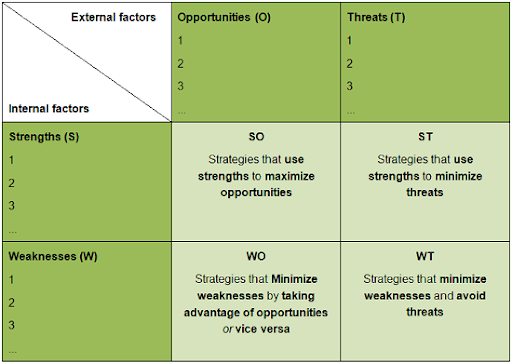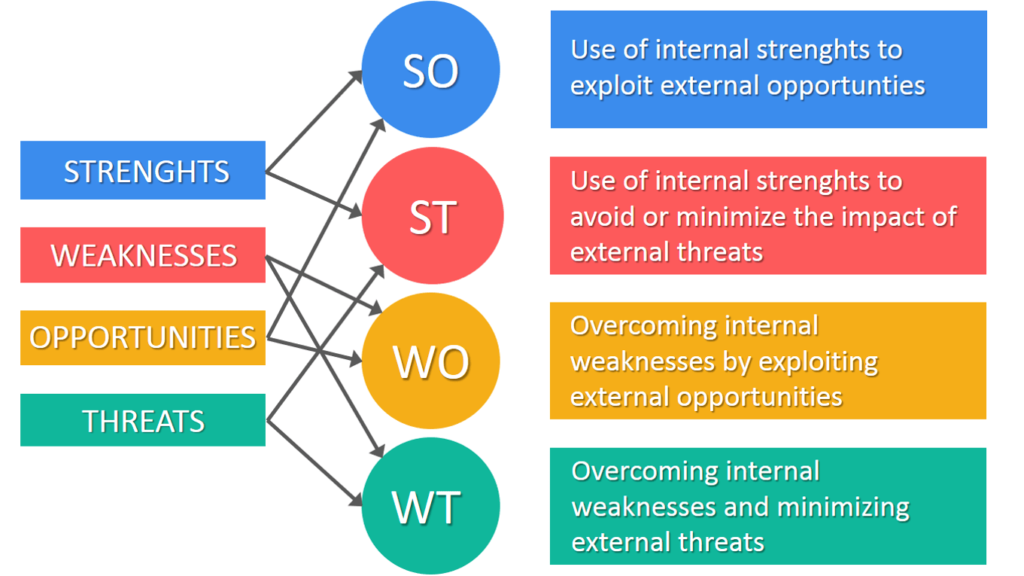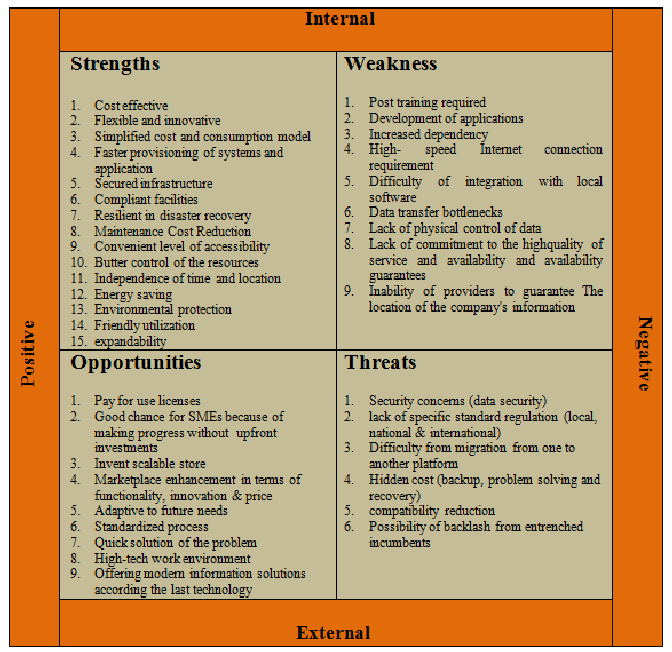SWOT analysis is a strategic management tool used to identify the strengths, weaknesses, opportunities and threats related to a project, organization or any strategic initiative. The term SWOT is an acronym that comes from the English words Strengths (strengths), Weaknesses (weaknesses), Opportunities (opportunities) and Threats (threat). This method allows decision-makers to have a global vision to better guide their strategic choices.

Page contents
ToggleSWOT Definition
Strengths : These are the internal advantages and strengths that an organization has over the competition. They may include resources, skills, or market positions that give the firm a position of relative superiority. Examples: patented technology, a highly qualified team, a good reputation, etc.
Weaknesses : These are the internal aspects that put the organization at a disadvantage compared to its competitors. This may include resource gaps, insufficient skills, inefficient processes, etc. Identifying weaknesses helps organizations improve or develop strategies to mitigate them.
Opportunities : These are the external elements that the organization can exploit to improve its performance and achieve its objectives. These opportunities may arise from various factors such as market changes, technology trends, regulatory changes, and other favorable industry dynamics.
Threat : These are also external factors, but unlike opportunities, threats could harm business performance if not managed properly. They may include changes in the industry environment, new competition, political risks, natural disasters, etc.
SWOT analysis is particularly useful for:
- Strategic planning : It helps organizations align their strategies according to their real environment and their internal capabilities.
- Decision making : It provides a clear framework for evaluating options and making informed decisions.
- Organizational development : By identifying strengths and weaknesses, organizations can plan development initiatives to strengthen their capabilities.
- Risk management : By anticipating threats, organizations can develop strategies to mitigate them before they become problematic.
Example of a fictitious company
Here is the SWOT analysis on a fictitious company called EcoTech, on technologies related to renewable energies. The SWOT analysis is commissioned by the company itself in order to position its discourse in the competitive market.
Strengths :
- Technological innovation : EcoTech owns several patents for solar panel technologies that provide superior efficiency compared to competing products.
- Solid reputation: The company has an excellent reputation for the quality and reliability of its products in the renewable energy industry.
- Government subsidies: EcoTech benefits from government subsidies promoting the development of renewable energies, which strengthens its financial position.
Weaknesses:
- High production costs: EcoTech's advanced technologies result in higher production costs, which affects price competitiveness compared to competitors who use less expensive technologies.
- Dependence on suppliers: The company relies on a limited number of suppliers for critical materials, which could pose risks in the event of a supply chain disruption.
Opportunities :
- Market expansion: New markets in Asia and Africa are showing growing interest in renewable energy solutions, representing a significant expansion opportunity for EcoTech.
- Strategic partnerships: Collaboration with construction companies and real estate developers could open new sales avenues for EcoTech's products.
- Technological innovations : Continued advances in batteries and energy storage provide opportunities for EcoTech to develop new, complementary products.
Threat :
- Increased competition: The entry of new players into the renewable energy sector, offering low-cost solutions, is intensifying competition.
- Regulatory fluctuations: Changes in environmental policies or government subsidies may unpredictably affect EcoTech's operations and profitability.
- Volatility of commodity prices: Fluctuations in the prices of materials needed to produce solar panels can impact the company's profit margins.
Example of a technological comparative analysis
Here is an example of a SWOT analysis comparing two types of photovoltaic panels: crystalline silicon-based panels and thin-film panels.
Crystalline silicon-based panels
Strengths :
- High efficiency: These panels offer higher solar conversion efficiency, making installations more productive on smaller areas.
- Sustainability : They are known for their longevity and resistance to harsh environmental conditions, guaranteeing a good return on investment in the long term.
Weaknesses:
- High cost : Manufacturing crystalline silicon-based panels is expensive due to the high purity of the material needed.
- Heavy weights : These panels are relatively heavy, which can limit their applicability on structures that cannot support a high weight.
Opportunities :
- Subsidies and incentives: Many markets offer subsidies for installing more efficient solar technologies, which could increase demand.
- Technological improvements: Advances in silicon technology could reduce costs and increase panel efficiency.
Threat :
- Competition from alternative technologies: The rise of thin-film panel technologies and other lower-cost alternatives could reduce the market share of crystalline silicon panels.
- Recycling issues: The challenges associated with recycling these panels could pose long-term environmental and reputational issues.
Thin layer panels
Strengths :
- Lower production cost: Manufacturing thin-film panels is generally less expensive, making the technology more accessible.
- Flexibility: These panels are lightweight and flexible, making them suitable for a wider variety of applications, including on irregular surfaces or lightweight structures.
Weaknesses:
- Lower efficiency: Thin-film panels have lower solar conversion efficiency compared to crystalline silicon panels.
- Less durability: They tend to have a shorter lifespan and may be more sensitive to environmental conditions.
Opportunities :
- Emerging Markets : Their low cost and flexibility make them ideal for developing markets where infrastructure for heavier, more expensive panels is not viable.
- Technological innovations : Advances in materials and manufacturing processes could improve their efficiency and sustainability.
Threat :
- Lower quality perception: The perception that these panels are inferior could limit their adoption in some high-end markets.
- Volatility of commodity prices: Fluctuations in the prices of materials needed to manufacture thin films can impact profit margins.
This SWOT analysis shows that although crystalline silicon-based panels currently dominate the market in terms of efficiency and durability, thin-film panels offer significant advantages in cost and flexibility. Technological advances and market changes could influence the future viability of these technologies. By continually evaluating strengths, weaknesses, opportunities and threats, manufacturers and investors can better navigate the solar PV competitive landscape.
SWOT analysis in technology monitoring
SWOT analysis is an extremely useful tool in the context of technology monitoring, especially in a constantly evolving technological environment. It allows businesses to not only stay up to date on the latest innovations, but also align these innovations with their overall business strategy. Here are several ways SWOT analysis is used in technology monitoring, taking into account the example of the two types of photovoltaic panels and other possible use cases.
SWOT analysis helps businesses to evaluate emerging technologies by breaking down their strengths, weaknesses, opportunities and threats. This helps identify technologies that have the potential to transform the sector, improve competitiveness, or present significant risks. For example, in the case of photovoltaic panels, a company could use SWOT analysis to decide whether to invest in thin-film technology or continue developing crystalline silicon-based panels.
Technology monitoring via SWOT analysis allows companies to ensure that their technological investments are in alignment with their strategic targets long-term. This involves ensuring that the technologies chosen not only meet current needs, but also can adapt to future developments in the market and regulatory environment.
It helps identify potential threats (risk management) associated with the adoption of new technologies, such as changing regulations, new competitors, or unresolved technical challenges. Thus, companies can develop proactive strategies to mitigate these risks before they become problematic.
The use of SWOT analysis in technology monitoring also helps companies optimizeallocation of resources. By understanding the strengths and weaknesses of different technologies, decision-makers can better allocate the R&D budget, focus marketing efforts on the most promising technologies, and potentially abandon less viable projects.
In a technological environment, where changes are rapid and frequent, SWOT analysis is not a one-off exercise. It must be carried out regularly to capture the evolving technology and market dynamics. This enables continuous adaptation of technology and business strategy, ensuring the business remains agile and responsive to innovations and market disruptions.
Process of a SWOT analysis in 6 steps
Here are the key steps to effectively include a SWOT analysis in the technology monitoring process:
Step 1: Definition of Technology Monitoring Objectives
Before starting the SWOT analysis, it is essential to clearly define the objectives of the technology watch. This could include identifying new disruptive technologies, monitoring competitor movements, or assessing emerging trends that could affect the industry. These objectives will guide the specific aspects of the technology or market to monitor.
Step 2: Data Collection and Analysis
Data collection is the foundation of any SWOT analysis. In the context of technology monitoring, this involves the systematic monitoring of information sources such as industrial publications, patents, academic articles, competing products, and customer feedback. The data collected should cover all four aspects of the SWOT analysis: strengths, weaknesses, opportunities and threats.
Step 3: Carrying out the SWOT Analysis
- Strengths : Identify internal technological advantages, unique skills, or proprietary resources that the company possesses relative to its competitors in the technological context being monitored.
- Weaknesses: Identify internal gaps in technological capabilities, resources, or strategies that could limit the effectiveness or impact of technologies in question.
- Opportunities : Evaluate external trends and market developments that could be leveraged to improve the company's technological or strategic position.
- Threat : Identify external risks, including competitive innovations, regulatory changes or substitute technologies that could compromise the company's position.
Step 4: Formulation of Strategies
On the basis of results of SWOT analysis, develop strategies that exploit strengths and opportunities, while addressing weaknesses and mitigating threats. This may include investing in R&D to develop technological capabilities, adjusting product plans to anticipate market movements, or strengthening IP protections against competitive risks.
Step 5: Implementation and Evaluation
The strategies developed must be implemented through specific projects or initiatives. The effectiveness of these strategies should be regularly evaluated against the initial objectives of technology monitoring. Periodic reviews of the SWOT analysis are necessary to ensure that it remains relevant and responsive to rapid changes in the technological environment.
Step 6: Communication of Results
Share SWOT analysis results and insights with key stakeholders, including management teams, R&D departments, marketing, and sales. This facilitates informed decision-making across the organization and ensures that all departments are aligned with the overall technology strategy.
SWOT analysis tools
SWOT Matrix
The most basic and widely used tool for performing a SWOT analysis is the SWOT matrix. It is a simple 2×2 grid where each quadrant represents an aspect of the SWOT: Strengths, Weaknesses, Opportunities and Threats. This visual format helps to clearly categorize and compare internal and external factors affecting an organization or project.
TOWS Matrix
An extension of the basic SWOT matrix, the TOWS matrix goes further by directly linking external opportunities and threats with internal strengths and weaknesses to identify strategic options. This matrix is particularly useful for strategic planning, as it helps develop strategies that:
- Exploit strengths to capitalize on opportunities (SO strategies).
- Address weaknesses by exploiting opportunities (WO strategies).
- Use strengths to mitigate threats (ST strategies).
- Minimize weaknesses and avoid threats (WT strategies).

Here is another way to understand the SW and OT interaction:

Comparative SWOT Analysis
To compare several objects (such as technologies, products or companies), a comparative SWOT analysis can be used. This approach involves creating a SWOT matrix for each object and placing them side by side. This format helps stakeholders see the relative strengths, weaknesses, opportunities, and threats between the analyzed objects.
In the case of a comparative analysis, it is possible not to analyze the interaction between the letters, in this case, refer to the following table:

Pros and Cons of SWOT Analysis
Here is a comparative table of the advantages and disadvantages of SWOT analysis compared to other strategic frameworks such as PESTEL analysis, Porter's Five Forces, Ansoff Matrix, BCG Matrix, and Scorecard Prospective. This table illustrates how SWOT analysis stacks up to these methods in terms of versatility, focus, and usefulness in strategic planning.
| Strategic Framework | Benefits | Disadvantages |
|---|---|---|
| SWOT analysis | – Simple and easy to use.- Offers a balanced view of internal and external factors.- Flexible, can be used with other strategic tools.- Good for brainstorming. | – Lack of depth in competitive analysis. – May be too simplistic, lacking complex dynamics. Don't prioritize factors. |
| PESTEL analysis | – Focuses on external macro-environmental factors that could affect the organization. – Helps understand market growth or decline. | – Does not consider internal factors. – May be too broad, lacking focus on specific strategies. |
| Porter's Five Forces | – Provides in-depth analysis of industry structure and competitive intensity. – Helps understand the profitability of industries. | – Mainly focuses on industry level analysis, not individual companies. – Can be complex and time consuming to analyze. |
| Ansoff matrix | – Focuses on growth opportunities. – Clear options for market and product development strategies. | – Does not consider potential obstacles or threats. – Mainly suited for growth strategies, less for contraction or stability. |
| BCG matrix | – Helps allocate resources based on product performance and market growth. – Useful for large companies with diversified product portfolios. | – Can oversimplify complex market dynamics. – Less effective in fast-paced industries where product life cycles are short. |
| Prospective Dashboard | – Links strategic objectives to performance indicators.- Considers financial and non-financial aspects.- Promotes strategic communication within the organization. | – Implementation can be complex and resource intensive. – Requires ongoing updates and may require significant cultural changes in the organization to be effective. |